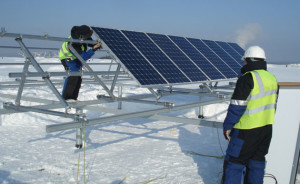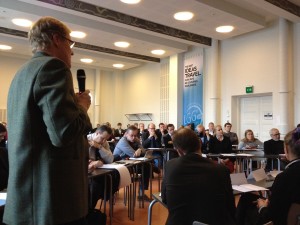 Due to the extensive and rapid developments in solar energy industry, there is still some outdated information about solar energy in the market. FinSolar -project aims to fill this information gap by addressing the most common statements about solar energy.
Due to the extensive and rapid developments in solar energy industry, there is still some outdated information about solar energy in the market. FinSolar -project aims to fill this information gap by addressing the most common statements about solar energy.
1. Solar energy is not suitable for Finland because of the cold and long winter.
The suitability of solar energy can be evaluated from two perspectives: The financial profitability or the ecological outcomes. Financial profitability will be further discussed in chapter 2 and ecological perspective in chapters 3 and 6.
The long dark winter period does not have affect the production volumes that much. Solar PV systems in Finland produce the same amount of energy annually as their counterparts in northern Germany. This is due to the similar levels of annual solar irradiation between Frankfurt and Southern Finland. The long periods of daylight in the summer compensate the winter darkness. The installation angle of the panels is more crucial to the annual yield levels than the irradiation total. In addition, the cooler climate in Finland increases the output of solar panels compared to warmer countries.
- Solar energy is not financially feasible in Finland.
Financial outcome of solar installments depends on a selection of variables. Even though the investment pay back times are relatively long, the decreasing component prices, technological developments and exemption on taxes and distribution fees have enabled financial feasibility. Especially in cases where the comparison price of energy is relatively high and the solar system is scaled to be consumed at the site of production, solar energy investments can lead even to high financial yields. Financial feasibility of solar investments in Finland can further be explored through FinSolar calculators.
Financial outcome of solar investments is also highly dependent on the political guidelines such as support systems, taxation and prices of alternative energy sources. The long term electricity prices in Finland have been on the rise in the 21st century, although the recent years have shown more negative progress.
- The lifecycle analysis of solar systems reveals, that the amount of energy consumed in manufacturing the system will not be replaced by the amount of energy the system will produce during it’s lifetime. Therefore, solar energy installments have little effect on CO2 emissions.
This is a false statement. Energy payback time is an indicator for the amount of time the system has to operate in order to reproduce the energy consumed in it’s production. The estimates for energy payback time for solar PV vary between 0,75 and 5 years and for solar thermal systems 1-3,5 years. The lifetime for a solar system is 30 years with zero emission per energy produced, which proves a high positive balance on energy life cycle evaluation. However, energy payback time varies according to location, manufacturing materials, weather conditions and system lifespan. According to a study conducted in 2011, northern european solar installments produce five times their manufacturing energy during their lifetime.
- Solar system investments should only be purchased if the whole annual energy consumption of the building can be covered with it.
This is a false statement. A correct adjusting of the size of the solar system is one of the key variables to a financially sound investment. This relies more on the lowest amount of energy consumption on a given time rather than the annual energy consumption figures. In Finland, solar energy is always a supplementary energy production form and should be combined with other sources of energy such as bio energy or heat pumps. The Finnish energy production network has a long tradition of using multiple energy production technologies and solar energy is a good addition to this network.
This depends entirely on the technology in question and the installation. By choosing technologies that are designed for Finnish weather conditions and taking snow loads into account when choosing the installation angle, the effects of snow can be minimized. According to a research conducted in 2013, Ontario, Canada, snow only decreased the annual production levels by 1- 3,5 percents. The loss of production caused by snow coverage is usually at the darkest time of the year when the yield would not be as large in any case.
- The minerals needed for solar panels and collectors are a finite resource. It is crucial to enable the future availability or to replace the most critical materials.
This is true. Even if solar energy in itself is emissions free, manufacturing the systems has some negative environmental consequences. A report by Finnish Ministry of Environment, 2014, describes mineral raw materials as the most critical component in solar energy. For example metal resources such as silver, aluminum, indium and gallium, can cause availability issues in the nearby future. However, raw material issues are not unique to solar technologies. The European Union has started to address the challenge by establishing WEE-directive in 2014. The directive includes all collection, remanufacturing and recycling activities for electric waste.
Investing in solar energy does not necessarily require the buyer taking part in the permission process. Many of the system suppliers include handling the bureaucracy process to their turn-key deliveries. In Finland, the amount of paper work for solar installments is dependent on the municipality in which the solar energy system will be. Some cities and municipalities require a operation permit. Housing cooperatives installments require a permission from the board.
- Solar energy does not help the Finnish economy because the panels are mostly Chinese.
This is false. A research made by FinSolar -project in 2015 indicates that the share of domestic income from solar investments is relatively high. The research included the financial flows of four solar thermal and solar PV installments. The rate of domestic income from the total financial flow varied between 48% and 70%. Higher rates indicated that more domestic components were used but even when the panels were imported from abroad, the domestic income rate stayed close to 50%.
Written by:
Julia Müller, FinSolar intern in 2015
References
Statement 1.
Albrecht Johan, Dewulf Jo, Laleman Ruben, 2011: Life Cycle Analysis to estimate the environmental impact of residential photovoltaic systems in regions with a low solar irradiation. Renewable and Sustainable Energy Rewievs, Vol 15, 267.
Jinqing Peng, Lin Lu, Hongxing Yang, 2013: Review on life cycle assessment of energy payback and greenhouse gas emission of solar pholovoltaic systems. Renewable and Sustainable Energy Reviews. Vol 19, 255.
Kekkonen Alpo, 2014; Tuuli- ja aurinkosähköntuotannon oppimisympäristö, TUURINKO. Aurinkoenergian saatavuus ja aurinkosähköntuotannon taloudellinen kannattavuus Pohjois-Pohjanmaalla. Koulutustilaisuuden luentomateriaalit. Oulun Ammattikorkeakoulu.
Statement 2.
Laki sähkön ja eräiden polttoaineiden valmisteverosta. Referred 13.07.2015.
Välimäki Matti, 2014; Kannattavuutta uusiutuvan energian markkinoille uudella palvelumallilla. Laurea-ammattikorkeakoulu. Opinnäytetyö. Sivut 14‒15.
Statement 3.
Albrecht Johan, Dewulf Jo, Laleman Ruben, 2011: Life Cycle Analysis to estimate the environmental impact of residential photovoltaic systems in regions with a low solar irradiation. Renewable and Sustainable Energy Rewievs, Vol 15, 267.
Goh Li Jin, Adnan Ibrahim, Yee Kim Chean, Roonak Daghigh, Hafidz Ruslan, Sohif Mat, Mohd. Yusof Othman, Kamaruzaman Ibrahim, Azami Zaharim, Kamaruzaman Sopian, 2010: Evaluation of Single-Pass Photovoltaic-Thermal Air Collector with Rectangle Tunnel Absorber. Solar Energy Research Instiute, Universiti Kebangsaan Malaysia. 493.
Weißbach, G. Ruprecht, A. Huke, K. Czerski, S. Gottlieb, A. Hussein, 2013: Energy intensities, EROIs and energy payback times of electricity generating power plants. Energy. Vol 52, 15.
Statement 4.
Berninger Kati, 2013: Hiilineutraali Suomi – luento materiaali. Fysiikan täydennyskoulutuskurssi.
Tina, S. Gagliano, S. Raiti, 2006: Hybrid solar/wind power system probabilistic modelling for long-term performance assessment. Solar Energy. Vol 80, 578‒588.
Statement 5.
Andrews Rob W., Pearce Joshuan M., Pollard Andrew, 2013: The effects of snowfall on solar photovoltaic performance. Solar Energy, Vol 92, 84‒97.
Statement 6.
Leskinen Pekka, Holma Anne, Kaisa Manninen, Sinkko Taija, Pasanen Karri, Rantala Mirja, Sokka Laura, 2014: Uusiutuvan energian tuotannon ja käytön ympäristövaikutukset ja -riskit. Ympäristöministeriön raportteja 9. Kirjallisuuskatsaus ja asiantuntija-arvio.
Smarter use of scarce resources: Commission launches flagship initiative for sustainable growth. Referred 13.7.2015.
Solar Waste/ European WEE directive. Referred 9.7.2015.
Statement 7.
Lupa-asiat. Motiva Oy verkkosivut. Referred 13.07.2015.
Statement 8.
Aurinkoenergia tuo Suomeen rahaa ja työtä. Kauppalehti 7.7.2015. Referred 8.7.2015.
Written by: Julia Müller, FinSolar intern


